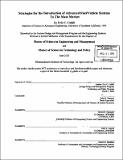Strategies for the introduction of advanced fuel/vehicle systems to the mass market
Author(s)
Cahill, Eric C. (Eric Christopher), 1971-
DownloadFull printable version (13.70Mb)
Other Contributors
System Design and Management Program.
Advisor
John D. Sterman.
Terms of use
Metadata
Show full item recordAbstract
The case for proactive market interventions to stimulate accelerated development and adoption of cleaner advanced fuel/vehicle systems continues to gain momentum globally. World population growth, rising national wealth, persistence of auto-centric land development patterns, and the growing popularity of truck-based platforms have reversed the trend toward lighter vehicles, higher fuel efficiencies, and cleaner emissions that began in the 1970's. Since 1984, fuel efficiency has stagnated and even declined as oil prices moved to historically low levels. Lack of consumer demand for fuel economy served to shift investment toward other measures of value such as performance and utility. The convergence of car and truck markets has further impeded progress on the fuel economy front. Industry continues to come under intensifying pressure from international and domestic concerns regarding adverse vehicle emissions impacts on public health, environmental degradation, global climate change, and national security vulnerabilities stemming from dependence on foreign oil. In response, the world's major auto conglomerates have embarked on a variety of strategies to deliver cleaner vehicles to market. Strategies span in-house and strategic partnering efforts across a range of both available and developing technologies in fuels, batteries, fuel cells, electric hybrids, and improvements to current internal combustion engine (ICE) designs. This thesis intends to examine a set of representative technological solution pathways that address two key questions for decision-makers: (1) whether market adoption of advanced fuel/vehicle systems can occur under plausible conditions, and (2) what industry strategies and public interventions can best leverage innovation to achieve the accelerated adoption of technologies beneficial to sustainability goals? To answer these questions, the work employs a system dynamics-based model in order to simulate the complex dynamics surrounding this issue. The model provides a useful framework for comprehending the relative directional impacts of varying industry strategies, public interventions, and external market and cultural forces that affect potential outcomes. The work suggests that plausible adoption scenarios are realizable within a thirty-year time horizon, but that forces deleterious to the innovative capacity of established domestic firms may significantly impede progress. I outline these forces, explain their origins, and recommend industry strategies and public interventions that appropriately address these obstacles.
Description
Thesis (S.M.)--Massachusetts Institute of Technology, System Design & Management Program, 2002. Includes bibliographical references (p. 184-187).
Date issued
2002Department
System Design and Management Program.Publisher
Massachusetts Institute of Technology
Keywords
System Design and Management Program.